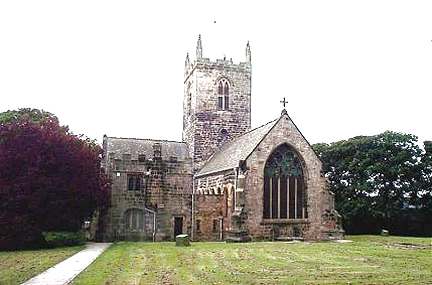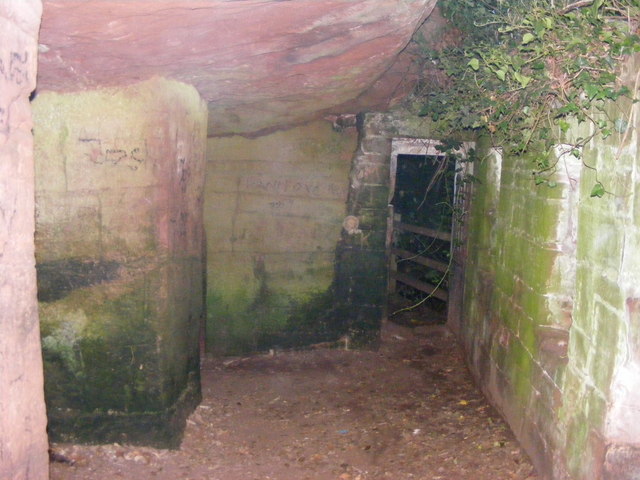Topics > Tyne and Wear > Sunderland > Houghton-le-Spring > Houghton-le-Spring, Historical Account, 1890
Houghton-le-Spring, Historical Account, 1890
Extract from: Kelly's Directory of Durham, 1890
HOUGHTON LE SPRING is a union town, township and parish, situated on the road from Durham to Sunderland, 262 miles from London, 6 north-east from Durham, 14 south-east from Newcastle and 6½ south-west from Sunderland, in the Houghton-le-Spring division of the county, north division of Easington ward, Durham county court district, rural deanery of Houghton-le-Spring and archdeaconry and diocese of Durham. The affairs of the town are controlled by a Board of Health, formed 5th September, 1854, and consisting of nine members. The North Eastern railway passes about 2 miles west, where there is a station at Fence Houses: various lines of railways intersect this parish for the conveyance of coals to Sunderland and Seaham Harbour. The church of St. Michael is a large cruciform embattled building of stone in the Early English and Decorated styles, and consists of chancel, nave of five bays, aisles, transepts, south porch and an embattled central tower with octagonal crocketed turrets, and containing a clock and 6 bells: the nave was rebuilt about 1350, and at the same time new windows were inserted; the transepts, however, retain some early quatrefoil-headed windows of two lights, probably quite unique, and there are still lancets in the north transept and chancel, but the east window is Decorated, and has good flowing tracery, and there is a similar window at the west end: each transept has a piscina: the south wall of the chancel is pierced by a Norman doorway and window belonging to the earlier fabric; and between the chancel and south transept stands a battlemented structure, connected with the church by a covered passage, and used as a vestry: in the chancel is an altar tomb erected to Margery, widow of Richard Bellassis, of Henknowle, ob, 1587, aet. 90: the brass formerly on the upper slab was some time since removed to the south transept, where also stands the massive altar tomb of the famous reformer, Bernard Gilpin, rector here from about 1556, who died 4th March, 1583; the sides of the tomb are ornamented with panelled work, and at one end is a shield of arms and inscription: near this tomb lies the mutilated recumbent effigy of a knight in mail armour, variously assigned to Sir Roland Belasyse, knighted at the battle of Lewes, 14th May, 1264, and to Sir John le Spring, lord of this place 1332-3, who was murdered in the manor house: there is also a memorial to George Davenport, rector, ob. 1677: nearly all the windows are stained: the church was restored about 1860, under the direction of the late Mr. Philip Hardwick, and has 800 sittings: the churchyard contains a curious small tomb with arcaded sides and a divided upper slab, each portion having a floriated cross at the head. The communion plate includes a new Set of silver, provided in 1889, at a cost of £100, from a bequest by the late Robert H. Allan esq. of Blackwell Hall, and consisting of a flagon, two chalices, two patens, and an alms dish. The register dates from the year 1563: there are also two volumes of churchwardens’ accounts, I. from 1592 to 1669; II. 1671 to 1704. The living is a rectory, tithe rent-charge £950, gross yearly value £1,600, including 343 acres of glebe, with residence, in the gift of the Bishop of Durham, and held since 1847 by the Rev. the Hon. John Grey M.A. of Trinity College, Cambridge, hon. canon of Durham, rural dean of Soughton-le-Spring, and chaplain to the Bishop of Durham. The rectory, crenellated by license in 1483, and once an interesting example of a semi-castellated residence, was partially rebuilt in 1664 by George Davenport, then rector, and a chapel added; but the latter, together with the ancient western tower, were removed by one of his successors; the house, however, still retains some of its ancient features, and in the garden is a thorn about 11 feet in girth, said to have been planted by Bernard Gilpin. St. Andrew’s, Chilton Moor, is an ecclesiastical parish, formed October 18, 1872, out of Houghton-le-Spring, E. and W. Rainton, and St. Matthew’s, Newbottle. The church, of which only the nave is at present erected, is a building of stone, and affords 200 sittings. The register dates from the year 1876. The living is a vicarage, yearly value £300, with residence, in the gift of the Crown and Bishop of Durham alternately, and held since 1872 by the Rev. Robert Louis Henri Gough M.A. of Brasenose College, Oxford. The Catholic church, dedicated to St. Michael, in the Durham road, and erected in 1837, is a building of stone in the Gothic style, consisting of chancel and nave, with a gallery: on the north side of the high altar is a beautifully decorated altar of the “Blessed Virgin:” the church will seat 500 persons, and has a spacious schoolroom beneath: a new presbytery is now (1889) in course of erection. There are the following chapels:-Wesleyan, in William street, erected at a cost of £900,500 sittings; Baptist, in Sunderland street, 130; Primitive Methodist, in Mautland street, 650; Free Methodist, in Nesham street, 200; and Presbyterian, in Church street, erected at a cost of £3,400, with sittings for 550 persons. The Davenport and Lilburne Almshouses, situated at the south-east angle of the churchyard, consist of a central block, with advanced gabled wings, and were founded in 1668 by George Lilburne, of Offerton, and enlarged by George Davenport, rector of Houghton, who built the south wing: the endowment amounts to £106 yearly, derived from land: the Rev. Sir George Wheeler’s charity of £100 per year is partly for the support of the Grammar school: Dr. Bagshaw’s, of £38 yearly, includes a yearly payment of £2 to the widows in the almshouses and of £5 to the girls’ school, besides £31 for distribution: Tempest’s, of £36, is for the support of pensioners: the remaining charities, amounting to about £13, are distributed in money. The Town Hall and Market House, erected in 1872, is a substantial building of brick with stone dressing; the large hall, 70 by 27 feet, will hold 500 persons, and has attached to it an ante-room and other apartments; the market is roofed with glass and contains a number of shops. The Church Institute, on the Quay, formerly the Mechanics’ Institute, was erected in 1851, on ground given, by T. W. U. Robinson esq. and built by subscription, at a cost of £500: it is a handsome edifice of stone, with a square tower over the entrance, and contains a good library of 800 volumes, besides being well supplied with the leading journals: the premises were purchased in 1888 by the late T. W. U. Robinson, and sold to the rector of Houghton by his widow. There is a large brewery. The greater portion of the inhabitants are employed in the mines which abound in this district, and there is an excellent limestone quarry worked by Mr. John Johnson, of Hetton. There are two good commercial hotels, the “Golden Lion” and the “White Lion.” The celebrated Bernard Gilpin B.D. of Queen’s College and Christ Church, Oxford, usually styled “The Apostle of the North,” and born at Kentmire, Westmorland, in 1517, was rector of this parish 1556-83, and archdeacon of Durham; he died here 4th March 1583, in the 66th year of his age. The Rev. Sir George Wheeler kt. and prebendary of Durham, was rector here from 1708, and died 18th January, 1723. Houghton Hall, the seat of Sir George Elliot bart. M.P., D.L., J.P. is a rectangular mansion of three stories, situated north-east of the church, and was erected by Robert Hutton, rector here 1589-1623; it retains its mullioned windows, with a plain parapet, and is but slightly altered from its original design; in the grounds attached to the house is an altar-tomb with inscription, erected over the grave of Robert Hutton esq. son of the above-mentioned, and a captain of horse in the Parliamentary army, who died 9th August, 1680, and was here buried at his own request, probably on account of his Puritan views, but traditionally in order to lie near the remains of his favourite charger. The acreage of the township is 1,551; rateable value, £19,080; the population of the township in 1881 was 6,041, including 134 officers and inmates in the workhouse; area of township, 1,285 acres.
Petty Sessions are held at the Police Court every alternate Thursday at 11 a.m. The following townships are included in the Houghton-le-Spring Petty Sessional division :-South Biddick, Burn Moor, Cocken, Eppleton (Great), Eppleton (Little), Herrington (East & Middle), Herrington (West), Hetton-le-Hole, Houghton-le-Spring, Lambton, Lumley (Great), Lumley (Little), Moorsley, Morton Grange, Newbottle, Penshaw, Rainton (East), Bainton (West), Silksworth, Warden Law.
HOUGHTON-LE-SPRING UNION
Board day, Monday, fortnightly, at the Board room, Workhouse, Houghton-le-Spring, at 2 p.m.
The Union comprises the townships of Silksworth, East & Middle Herrington, West Herrington, Offerton, Penshaw, Newbottle, Morton Grange, Houghton-le-Spring, Warden Law, Great & Little Eppleton, Hetton-le-Hole, East & West Rainton, Moorsley & Moorhouse; the population in 1881 was 34,145; rateable value, £136,264.
Places of Worship
- St. Michael’s Church, Rev. the Hon. John Grey M.A. rector; Rev. Harry Becher, Rev. Thomas L. Lomax M.A. & Rev. J. G. Ryles B.A. curates.
- St. Andrew’s, Chilton Moor, Rev. R. L. H. Gouarh M.A.
- St. Michael’s Catholic Church, Durham road, Rev. John O’Brien, priest.
- Presbyterian Church, Church street, Rev. James Milligan D.D. minister.
- Primitive Methodist, Mautland street ministers, Rev;. J. Phillipson & Rev. R. Walton.
- Baptist, Sunderland street, ministers, various.
- Wesleyan, William street, ministers, Rev. J. W. Keyworth & Rev. Woodthorpe Baker.
- United Free Methodist, Nesham place, ministers, Rev. S. Beavan & Rev. E. Orme.
- Christian Lay Church, Union st. ministers, various.
- Salvation Army Barracks, Pottery yard.
Schools
- Royal Kepyer Grammar, founded by Bernard Gilpin, rector, & endowed in 1574 by John Heath, of Kepyer, from lands belonging to the dissolved Kepyer hospital, near Durham; the endowment amounts to about £180 yearly, derived from land & tithes: attached to the school are six open Foundation scholarships, one exhibition of £28 yearly, tenable for 4 years at Oxford, Cambridge or Durham; & 4 special annual prizes, each of 5 guineas, besides others of smaller amount: the school is managed by a governing body, & there are now about 50 boys, chiefly boarders; Rev, Alexander Bennett B.A.Lond. headmaster: among the eminent persons educated at this school were Hugh Broughton, theologian & hebraist, & fellow of Christ’s College, Cambridge, d. 4 Aug. 1612; George Carleton D.D. Bishop of Llandaff (1618-9) & of Chichester (1619-28), where he died in May, 1628.
- Catholic, Durham road (mixed & infants), built in 1880, for 300 children; average attendance, 175 .
- National, built in 1855, for 293 children; average attendance, 184.
- Lambton National (mixed), Newbottle street, built in 1872, for 304 children; average attendance, 133 boys & 107 girls.
- Lambton National (infants), Hopper street, for 200 children; average attendance, 162.
- National, New Town, built in 1868, for 70 children; average attendance, 43.
- Wesleyan, William street, built in 1861, for 267 children; average attendance, 255.
- National, Chilton Moor, built in 1872, for 519 children; average attendance, 162 boys, 161 girls & 140 infants.

Co-Curate Page
Church of St Michael and All Angels
- Overview Map Street View Inside St Michael and All Angels is the parish church in Houghton-le-Spring. The church dates from the late 12th centuty. It has a C13th chancel; C14th …











